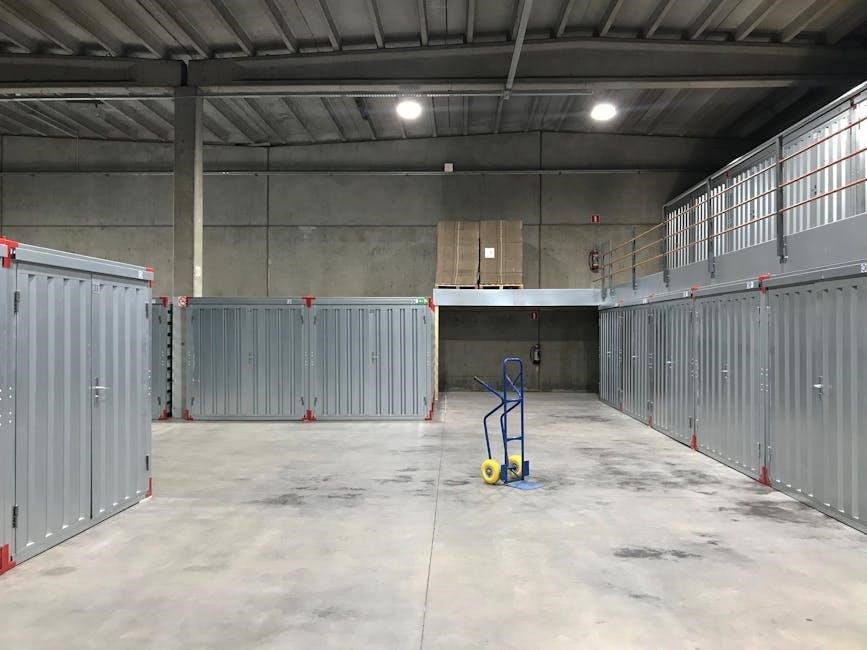
A safe work permit is a written authorization ensuring specific work is conducted safely. It outlines hazards, controls, and responsibilities, promoting compliance with safety regulations and standards.
What is a Safe Work Permit?
A safe work permit is a written authorization that identifies specific work activities, hazards, and safety measures. It ensures compliance with safety protocols and regulations, outlining the scope, duration, and responsibilities for the task. The permit is essential for high-risk activities, providing a clear record of approved work and ensuring all safety precautions are in place before work begins.
The Purpose of a Safe Work Permit
The purpose of a safe work permit is to ensure that high-risk activities are conducted safely by identifying hazards, implementing controls, and assigning responsibilities. It provides a systematic approach to hazard management, ensuring compliance with safety regulations and company policies. The permit acts as a written record, verifying that all necessary precautions have been considered before work begins, thereby protecting workers, assets, and the environment from potential risks.

Key Elements of a Safe Work Permit
A safe work permit includes essential details such as the date, time, location, responsible department, and a clear description of the work to be performed.
Date, Time of Issue, and Expiry
The permit must clearly state the date and time it is issued and when it expires. This ensures the authorization is valid only for the specified duration, preventing unauthorized work. The expiry time is crucial to maintain safety protocols and accountability, allowing for regular reassessments of risks.
Location of the Work
The permit must specify the exact location where the work will be performed. This detail is critical for identifying potential hazards and ensuring safety measures are tailored to the site. The location should be described clearly to avoid ambiguity, helping all stakeholders understand the work area and its boundaries. This specificity ensures everyone involved is aware of the designated workspace and associated risks.
Department or Company Responsible
The safe work permit must clearly identify the department or company responsible for the work. This ensures accountability and proper coordination of safety measures. Specifying the responsible entity helps in assigning roles, monitoring compliance, and addressing potential incidents. It also ensures that the designated group is aware of their obligations and can implement necessary safety protocols effectively. This section is crucial for maintaining clear communication and accountability throughout the work process.
Description of the Work
The safe work permit must include a detailed description of the work to be performed. This section outlines the specific tasks, materials, and equipment involved, ensuring clarity and understanding. It helps identify potential hazards and ensures that all safety measures are appropriately planned. A clear work description also aids in verifying that the work aligns with the permit’s conditions and safety standards, promoting effective risk management and compliance with safety protocols.

Types of Safe Work Permits
Common types include Confined Space Entry Permits for work in enclosed spaces, Hot Work Permits for activities like welding, and Permit-to-Work (PTW) systems for managing high-risk tasks.
Confined Space Entry Permit
A Confined Space Entry Permit is required for work in pits, tanks, and vessels. It specifies the confined space’s location and description, reasons for entry, and names of permit issuers, supervisors, and attendants. The permit includes safety requirements like oxygen levels and measures to control hazards, ensuring a safe environment with defined roles for monitoring and compliance.
Hot Work Permit
A Hot Work Permit is essential for operations like welding, cutting, or grinding, which generate sparks and may ignite flammable materials. It identifies fire hazards, outlines safety precautions, and ensures fire prevention measures are implemented. The permit specifies the work location, duration, and emergency procedures, requiring approval from authorized personnel to ensure compliance with fire safety standards and prevent accidents.
Permit-to-Work (PTW) System
The Permit-to-Work (PTW) system is a formal, structured process for controlling and managing work activities to ensure safety and compliance. It involves issuing permits for specific tasks, such as hot work or confined space entry, and ensures that risks are identified and mitigated. The PTW system assigns responsibilities to personnel, verifies safety measures, and maintains documentation, making it a critical component of workplace safety management and operational efficiency.
Process for Obtaining a Safe Work Permit
Obtaining a safe work permit involves requesting, reviewing, and approving the permit, followed by issuance and validation to ensure compliance with safety protocols and regulations.
Steps to Request a Permit
To request a safe work permit, identify the need and prepare a detailed request form. Include the work location, description, and potential hazards. Submit the form to the designated authority for review and approval. Ensure all required information is accurate and complete to avoid delays. Once approved, review the permit conditions and ensure understanding before commencing work. Maintain documentation for record-keeping and compliance purposes.
Review and Approval Process
The review and approval process involves assessing the permit request for safety and compliance. The issuing authority evaluates the work details, hazards, and controls. They may request additional information or modifications. Once satisfied, the permit is approved and issued. The approval ensures that all safety measures are in place, minimizing risks. Communication between the requester and issuer is crucial for a smooth and efficient process.
Issuance and Validation
After approval, the safe work permit is issued with a start and expiry time. It authorizes specific work within defined boundaries; The permit must be validated by all parties involved. Supervisors ensure the permit is followed, and any deviations render it invalid. Monitoring is continuous to maintain safety. The permit is revalidated if work extends beyond the expiry time. Compliance with the permit ensures adherence to safety protocols and regulations throughout the task.

Best Practices for Using Safe Work Permits
The permit is issued after approval, specifying start and expiry times. It must be validated by all parties involved. Supervisors ensure compliance and monitor adherence to safety measures. Any deviations invalidate the permit, requiring revalidation if work extends beyond the expiry time. This ensures continuous safety oversight and regulatory adherence throughout the task.
Hazard Identification and Risk Assessment
Hazard identification and risk assessment are critical steps in ensuring safe work practices. They involve systematically identifying potential dangers and evaluating their severity. This process helps in implementing controls to mitigate risks, ensuring a safer work environment. The permit system relies on accurate hazard identification to issue valid permits, ensuring compliance with safety protocols and regulations. Continuous assessment ensures ongoing safety throughout the task.
Training and Competency Requirements
Training and competency requirements ensure personnel understand safe work practices. Mandatory training covers hazard identification, permit procedures, and emergency protocols. Supervisors must verify that workers are competent to perform tasks safely. Regular updates and assessments ensure compliance with evolving standards. Proper training reduces risks and ensures adherence to safety protocols, fostering a culture of safety and accountability in the workplace.
Monitoring and Supervision
Monitoring and supervision are critical to ensuring compliance with safe work permits. Supervisors must oversee activities to confirm adherence to permit conditions and safety standards. Regular checks ensure hazards are controlled, and work remains within defined boundaries. Effective supervision involves clear communication and prompt intervention if deviations occur. Continuous monitoring helps identify and mitigate risks, ensuring the safety of personnel and the integrity of the work environment throughout the permit’s duration.
Documentation and Record-Keeping
Accurate documentation and record-keeping are essential for safe work permits. All permits must be thoroughly documented, including details of issuance, expiry, and adherence to conditions. Records should include signatures of authorized personnel, work completion status, and any deviations or incidents. Maintaining detailed logs ensures accountability, traceability, and compliance with legal requirements. Proper storage, both physical and digital, guarantees accessibility for audits and future reference, supporting a robust safety management system and regulatory adherence for up to 5 years.
Legal and Regulatory Compliance
Safe work permits must comply with relevant laws and regulations, ensuring adherence to safety standards and legal requirements to prevent violations and potential penalties or shutdowns.
Relevant Laws and Regulations
Safe work permits must adhere to regulations like OSHA standards, the Health and Safety at Work Act 2015, and local labor laws. These laws mandate permit requirements, ensuring compliance with safety protocols and legal standards. Employers must familiarize themselves with regional regulations to avoid violations. Compliance is mandatory, and failure to follow these laws can result in penalties or operational shutdowns.
Consequences of Non-Compliance
Non-compliance with safe work permit regulations can result in severe penalties, including fines, legal actions, and operational shutdowns. Organizations may face reputational damage, loss of licenses, and increased insurance costs. Employees and employers could be held liable for accidents caused by unsafe practices. Regulatory bodies may also impose stricter oversight, impacting business operations and profitability. Compliance is critical to avoiding these consequences and ensuring workplace safety.
Digital Solutions for Safe Work Permits
Digital solutions streamline permit processes with specialized software tools. They enhance efficiency, tracking, and accessibility, ensuring compliance and safety across all operations effectively.
Software Tools for Permit Management
Software tools for permit management automate and streamline the issuance, tracking, and monitoring of safe work permits. These digital solutions provide real-time updates, accessibility across devices, and customizable templates. They enable organizations to efficiently manage work permits, reducing delays and ensuring compliance with safety protocols. Advanced features include automated reminders for permit expirations, electronic approvals, and integration with safety management systems. These tools enhance transparency, accountability, and overall safety in the workplace.
Benefits of Electronic Permits
Electronic permits enhance efficiency, reduce errors, and improve compliance with safety standards. They enable real-time monitoring, instant accessibility, and streamlined approval processes. Digital permits also minimize delays, reduce storage needs, and provide audit trails for accountability. Automated reminders ensure permits are renewed on time, while version control prevents outdated documents from being used. This digital approach supports environmental sustainability by reducing paper usage, making it a modern and practical solution for workplace safety management.

Training and Continuous Improvement
Training and continuous improvement ensure workers understand safe work permits and their importance. Regular workshops, seminars, and case studies enhance knowledge and foster a safer work environment.
Workshops and Seminars
Workshops and seminars provide interactive learning opportunities to understand safe work permits. These sessions cover permit systems, hazard identification, and compliance. Practical exercises and real-life examples help participants apply knowledge effectively. Regular training fosters a culture of safety, ensuring workers understand their roles in maintaining a safe work environment. These sessions also address updates in regulations and industry best practices, promoting continuous improvement in workplace safety standards and procedures.
Case Studies and Lessons Learned
Case studies and lessons learned provide real-life examples of incidents involving safe work permits. These analyses highlight successes and failures, offering insights into improving safety practices. By reviewing specific incidents, organizations can identify root causes and implement corrective actions. Sharing these lessons ensures continuous improvement and prevents repeat incidents, fostering a safer work environment and enhancing overall safety management systems and permit processes.